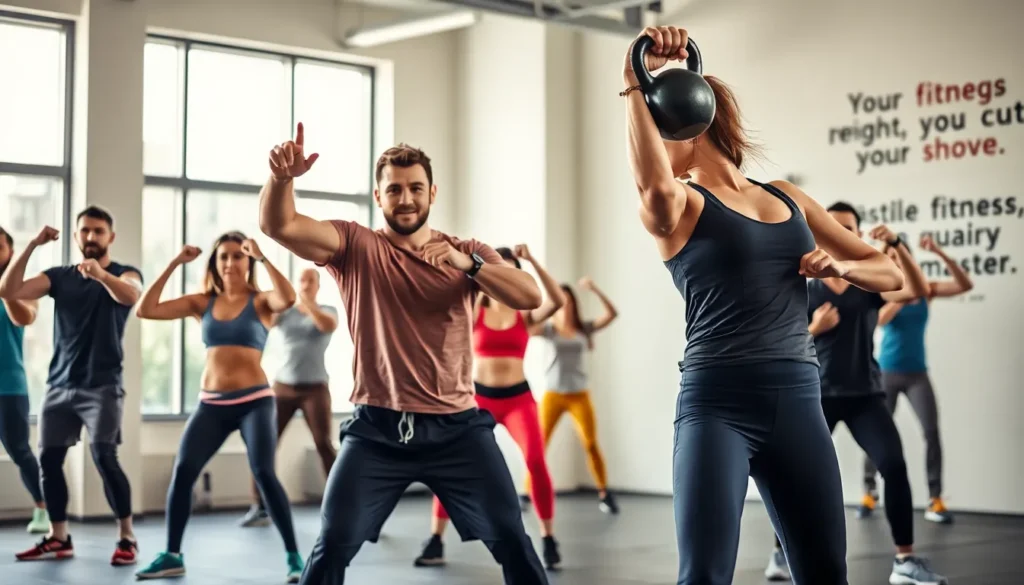Imagine lifting your groceries without straining or squatting to pick up a dropped pen without risking a back injury. Welcome to the world of functional fitness training. This isn’t just another workout trend: it’s a revolutionary approach that prepares your body for everyday activities. Whether you’re chasing after kids or tackling household chores, functional fitness has your back, literally. Let’s immerse and explore how this training program can reshape how you move through life, all while adding a sprinkle of fun along the way.
Table of Contents
ToggleUnderstanding Functional Fitness

Functional fitness training focuses on exercises that simulate everyday activities. Unlike traditional workouts, which often isolate specific muscles, functional training emphasizes movements that engage multiple muscle groups. This holistic approach helps improve strength, balance, and coordination, making daily tasks easier and safer. Think of it as a bridge connecting the gym to your living room.
Consider exercises like squats, lunges, or lifting weights while balancing on one foot. These movements mimic real-life situations, like lifting that heavy box in the corner of your garage. The beauty of this training lies in its ability to enhance not just your muscular strength but also your functional mobility. It’s all about performing daily activities with improved efficiency and reduced risk of injury.
Benefits of Functional Fitness Training
The advantages of functional fitness training are numerous. Here are some compelling reasons to integrate this type of training into your routine:
- Enhances Daily Life: Functionality is at the heart of it all. The skills learned during functional fitness training make mundane tasks, such as lifting objects, climbing stairs, or getting up from a chair, feel seamless.
- Injury Prevention: By reinforcing muscles that stabilize joints, functional exercises can significantly reduce the risk of injuries. A stronger foundation means the body can better handle unexpected movements, like tripping.
- Increased Flexibility and Stability: Functional fitness combines strength training with flexibility and stability exercises, promoting a balanced physique. For instance, incorporating core-strengthening routines can lead to better posture and reduced back pain.
- Versatile for All Ages: It caters to everyone. Whether you’re a senior trying to maintain independence or a young adult looking to enhance athletic performance, functional fitness is tailor-made for any age or fitness level.
- Time-efficient Workouts: Functional fitness typically incorporates compound movements, meaning you can achieve a full-body workout in less time, a major plus for busy schedules.
Key Components of a Functional Fitness Program
Creating a well-rounded functional fitness program includes various key components:
- Strength Training: Focus on exercises that work multiple muscle groups simultaneously, such as deadlifts and push-ups. These help in building muscular endurance and strength for daily lifts.
- Core Stability: This is crucial. A strong core supports the spine and improves overall body strength. Incorporate planks, Russian twists, and stability ball exercises.
- Flexibility Work: Stretching is essential for maintaining mobility. Dynamic stretching before workouts and static stretching afterward will keep the muscles pliable.
- Cardio Conditioning: Don’t skip out on cardio. Incorporate workouts that elevate the heart rate, like circuit training or jump rope, to improve overall fitness and endurance.
- Balance Exercises: As we age, maintaining balance becomes increasingly important. Exercises like single-leg stands or stability board work can significantly enhance stability.
Designing Your Functional Fitness Training Program
When designing a functional fitness training program, consider the following steps:
- Assess Your Current Fitness Level: Understand where you stand before starting. This will help in customizing your program. Be honest about your capabilities.
- Identify Goals: What are your specific objectives? Whether it’s improving endurance, increasing strength, or enhancing flexibility, setting clear goals will guide your training.
- Create a Balanced Routine: Ensure your weekly plan incorporates all key components: strength, cardio, flexibility, and balance. A well-rounded approach prevents overtraining and keeps workouts enjoyable.
- Schedule Consistency: Consistency is key for success. Determine how many days per week you can commit and stick to that schedule as much as possible.
- Progress Gradually: Start with lighter weights or simpler movements, and gradually increase intensity as your strength and stability improve. Listen to your body. It’s all about growth.
Sample Functional Fitness Workouts
Here’s a sample workout routine that showcases the beauty of functional fitness:
Warm-Up (10 Minutes)
- Dynamic stretching (arm circles, leg swings)
- Light aerobic activity (jogging in place or jump rope)
Workout (30 Minutes)
- Squats: 3 sets of 10-15 reps
- Push-Ups: 3 sets of 8-12 reps (modify on knees if necessary)
- Lunges: 3 sets of 10 reps per leg
- Planks: Hold for 30-60 seconds, repeat 3 times
- Kettlebell Swings: 3 sets of 12-15 reps
- Medicine Ball Throws: 3 sets of 10 reps
- Mountain Climbers: 3 sets of 30 seconds
Cool Down (10 Minutes)
- Static stretching focusing on major muscle groups
- Deep breathing exercises to relax
This sample routine is flexible and can easily be adjusted based on individual fitness levels.
Tips for Staying Motivated
Staying on track can sometimes be challenging, but here are a few tips to keep motivation high:
- Set Short-Term Goals: Achievable milestones can help maintain momentum. Celebrate small victories.
- Track Progress: Keep a journal or use fitness apps to monitor improvements over time. Seeing how far they’ve come can be incredibly motivating.
- Incorporate Variety: Try new exercises or activities. Switch things up to prevent boredom. Exploring outdoor workouts or group classes can add excitement.
- Find a Workout Buddy: Training with a friend can make workouts more enjoyable and holds each other accountable.
- Reflect on Your Why: Remind yourself why functional fitness matters. Whether it’s improving your health, feeling more vibrant, or gaining independence, keep that purpose at the forefront.








